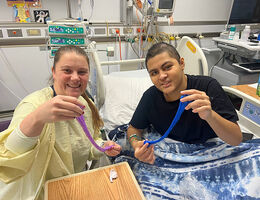
From left: mom Kati Gyulai, Aron Oriold, and father Alpar Oriold
When Kati Gyulai learned during her pregnancy that her baby’s arms and legs measured far shorter than average, she feared the worst.
“Toward the end of my pregnancy, the ultrasound showed his upper arm and thigh lengths were in the lowest first percentile,” Gyulai said. Doctors warned her and her husband, Alpar, that their child could be born with one of more than 200 types of skeletal dysplasia, some of which are fatal.
During delivery, an entire team stood by Gyulai, bracing for complications. Instead, she and her husband welcomed Aron, a beautiful baby boy with achondroplasia, the most common form of dwarfism. “We felt like we won the lottery,” Kati said of her son’s 1-in-25,000 odds.
“Achondroplasia is the most common genetic form of dwarfism,” said Hua Wang, MD, Aron’s geneticist at Loma Linda University Children’s Health. “It is caused by a mutation in the FGFR3 gene, which slows bone growth, especially in the arms and legs, leading to short stature with disproportionate limbs. Intelligence is normal, but children may face medical concerns involving bone structure, breathing, hearing, or mobility,” Wang said.
For Aron, those concerns surfaced quickly. “He had mild sleep apnea that improved after his tonsils and adenoids were removed, and some conductive hearing loss that improved with ear tubes,” Wang said. Aron also wears bifocal glasses to correct eye alignment and continues with speech and physical therapy.
Despite these hurdles, Kati says her son’s energy and determination have always shone through. “He’s never let anything hold him back.
Historically, families facing achondroplasia had very limited treatment options. Growth hormone provided minimal benefit and was rarely used. The only other option was limb-lengthening surgery, a highly invasive procedure that requires breaking the bones before they can be extended. That changed with the arrival of Voxzogo, the first FDA-approved medication that directly targets the underlying cause of the growth issue.
“Voxzogo works at the growth plates of bones to counteract the overactive FGFR3 signal, allowing bones to grow more normally,” Wang said. “It represents a major breakthrough. For the first time, we have a treatment that can improve growth and possibly body proportions in children with achondroplasia.”
Kati and her husband enrolled Aron in a clinical trial when he was a toddler, and when Voxzogo became available, they fought through months of insurance denials before finally gaining access with Wang’s help. “When we got the approval, we cried tears of joy,” Kati said.
Within his first year of treatment, Aron grew seven centimeters in height and increased his arm span by eight centimeters, growth that meets or exceeds the average for boys with achondroplasia on this medication. “This is clinically significant,” Wang said. “In the past, children with achondroplasia grew much more slowly after infancy.”
Beyond height, Wang hopes the therapy may help reduce joint strain, improve mobility, and potentially lessen the need for surgeries later in life.
“It’s possible. If bone proportions improve and certain structural risks are reduced, this could mean fewer orthopedic surgeries, such as leg straightening, and potentially less spinal or neurological intervention. However, long-term studies will be needed to confirm these benefits.”
Today, five-year-old Aron loves swimming, basketball, and soccer. He recently transitioned from special education preschool into a general classroom, where he is doing well.
For families navigating the challenges of achondroplasia, expert guidance and support can make all the difference.
“We provide clear, ongoing education, connect families to support groups, and ensure they have access to specialists for comprehensive care,” Wang said. “It’s important for families to know they’re not alone, especially since achondroplasia is lifelong, and decisions about treatments like Voxzogo involve balancing hope with realistic expectations.”


